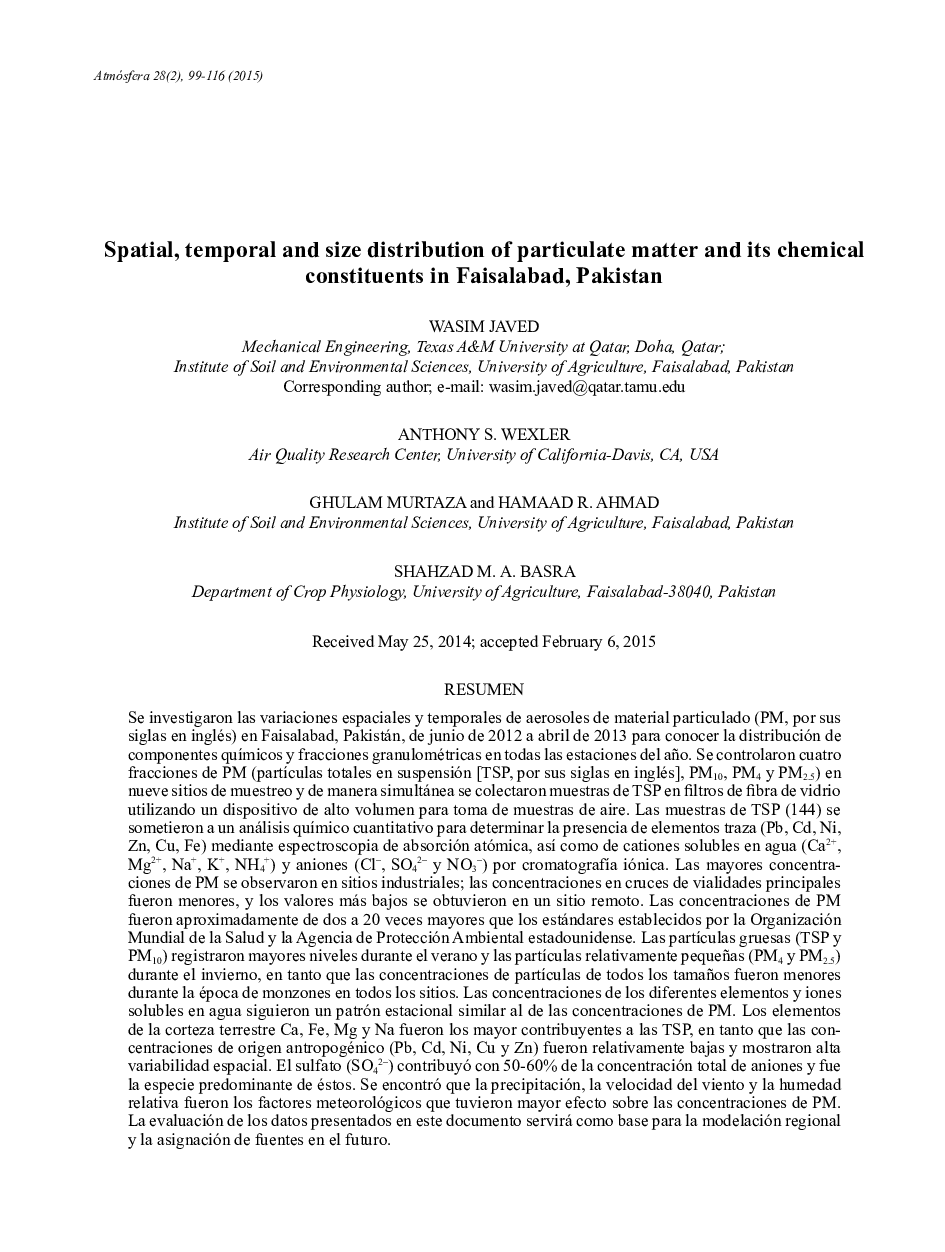| کد مقاله | کد نشریه | سال انتشار | مقاله انگلیسی | نسخه تمام متن |
|---|---|---|---|---|
| 4461962 | 1621533 | 2015 | 18 صفحه PDF | دانلود رایگان |
ResumenSe investigaron las variaciones espaciales y temporales de aerosoles de material particulado (PM, por sus siglas en inglés) en Faisalabad, Pakistán, de junio de 2012 a abril de 2013 para conocer la distribución de componentes químicos y fracciones granulométricas en todas las estaciones del año. Se controlaron cuatro fracciones de PM (partículas totales en suspensión [TSP, por sus siglas en inglés], PM10, PM4 y PM2.5) en nueve sitios de muestreo y de manera simultánea se colectaron muestras de TSP en filtros de fibra de vidrio utilizando un dispositivo de alto volumen para toma de muestras de aire. Las muestras de TSP (144) se sometieron a un análisis químico cuantitativo para determinar la presencia de elementos traza (Pb, Cd, Ni, Zn, Cu, Fe) mediante espectroscopia de absorción atómica, así como de cationes solubles en agua (Ca2+, Mg2+, Na+, K+, NH4+) y aniones (Cl–, SO42– y NO3–) por cromatografía iónica. Las mayores concentraciones de PM se observaron en sitios industriales; las concentraciones en cruces de vialidades principales fueron menores, y los valores más bajos se obtuvieron en un sitio remoto. Las concentraciones de PM fueron aproximadamente de dos a 20 veces mayores que los estándares establecidos por la Organización Mundial de la Salud y la Agencia de Protección Ambiental estadounidense. Las partículas gruesas (TSP y PM10) registraron mayores niveles durante el verano y las partículas relativamente pequeñas (PM4 y PM2.5) durante el invierno, en tanto que las concentraciones de partículas de todos los tamaños fueron menores durante la época de monzones en todos los sitios. Las concentraciones de los diferentes elementos y iones solubles en agua siguieron un patrón estacional similar al de las concentraciones de PM. Los elementos de la corteza terrestre Ca, Fe, Mg y Na fueron los mayor contribuyentes a las TSP, en tanto que las concentraciones de origen antropogénico (Pb, Cd, Ni, Cu y Zn) fueron relativamente bajas y mostraron alta variabilidad espacial. El sulfato (SO42–) contribuyó con 50-60% de la concentración total de aniones y fue la especie predominante de éstos. Se encontró que la precipitación, la velocidad del viento y la humedad relativa fueron los factores meteorológicos que tuvieron mayor efecto sobre las concentraciones de PM. La evaluación de los datos presentados en este documento servirá como base para la modelación regional y la asignación de fuentes en el futuro.
Spatial and temporal variations in aerosol particulate matter (PM) were investigated for distribution over the four seasons of chemical constituents and particle size fractions in Faisalabad, Pakistan from June 2012 to April 2013. At nine sampling sites, four PM mass size fractions (total suspended particulates [TSP], PM10, PM4 and PM2.5) were monitored; simultaneously, TSP mass samples were collected on glass fiber filters using a high volume air sampler. TSP samples (144) were subjected to quantitative chemical analyses for determining trace elements (Pb, Cd, Ni, Zn, Cu, Fe) using atomic absorption spectroscopy, and water-soluble cations (Ca2+, Mg2+, Na+, K+, NH4+) and anions (Cl–, SO42– and NO3–) by ion chromatography. The highest PM mass concentrations were observed at industrial sites, while they were somewhat lower in major road intersections and lowest in the remote background site. It was also observed that PM mass concentrations were about two to 20 times higher than the standard limits of the World Health Organization and the US Environmental Protection Agency. Coarse particles (TSP, PM10 and PM4) were found to be highest during the summer, while relatively fine particles (PM2.5) were higher during the winter period. Concentrations of all size fractions were lowest during the monsoon sampling period at all sites. Concentrations of different elements and water-soluble ions also followed the similar temporal pattern as PM mass concentrations. The crustal elements Ca, Fe, Mg and Na were the largest contributors to TSP mass while elements of anthropogenic origin (Pb, Cd, Ni, Cu and Zn) had relatively lower concentrations and also showed a high spatial variation. Among the anions, sulfate (SO42–) was the predominant species contributing to 50-60% of the total anion concentration. It was found that rainfall, wind speed and relative humidity were the most important meteorological factors affecting PM concentrations. The evaluation of data presented in this paper will serve as a basis for future regional modeling and source apportionment.
Journal: Atmósfera - Volume 28, Issue 2, April 2015, Pages 99–116
